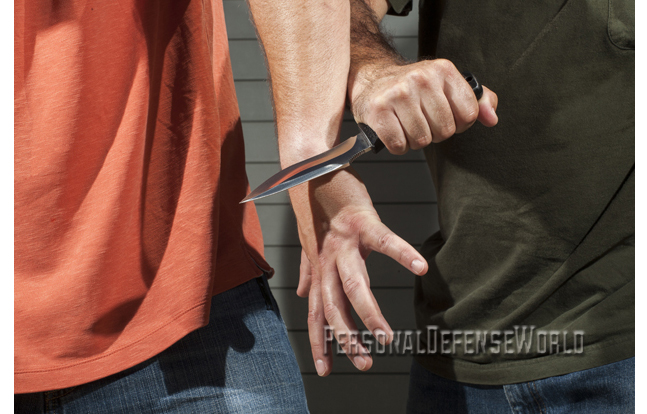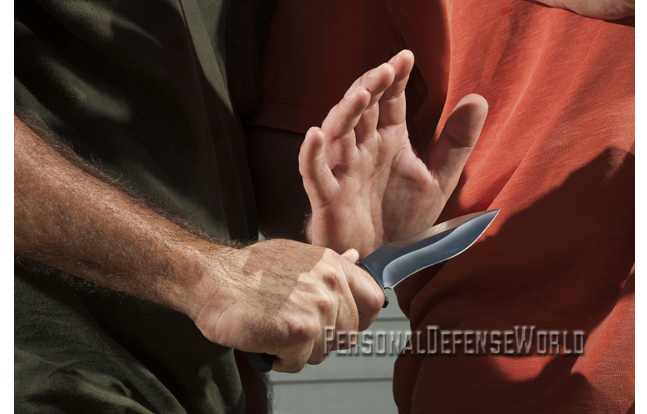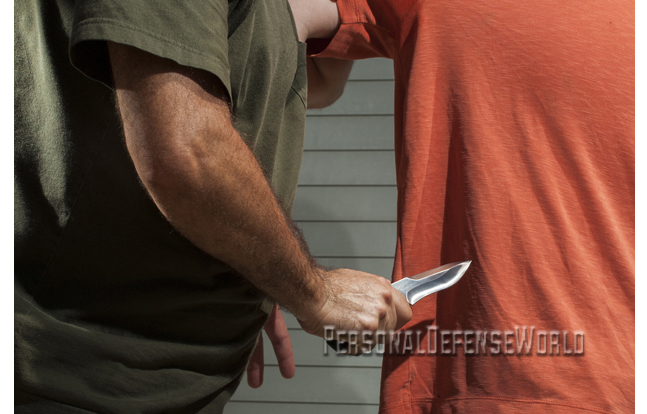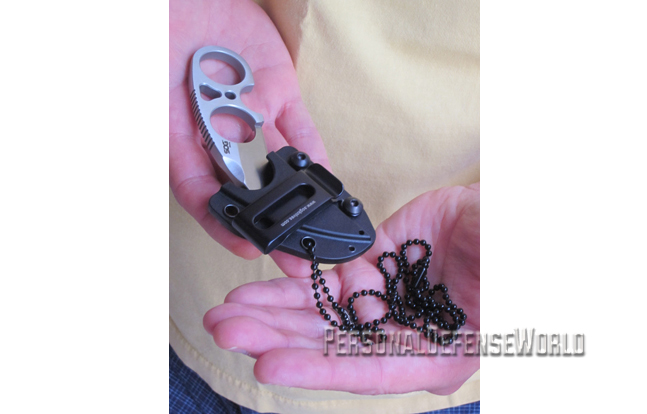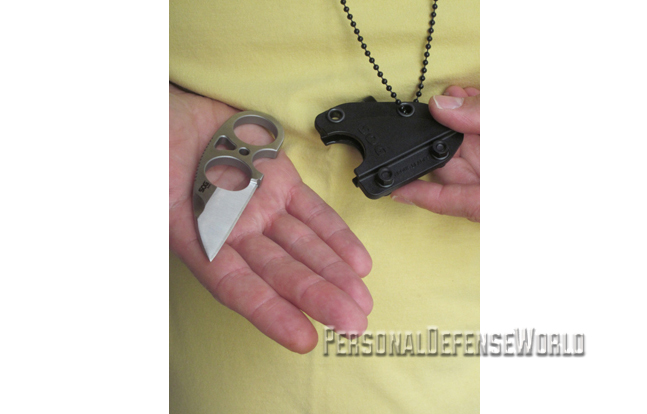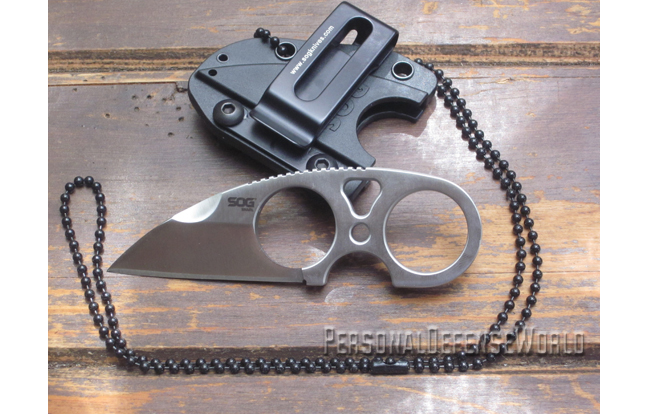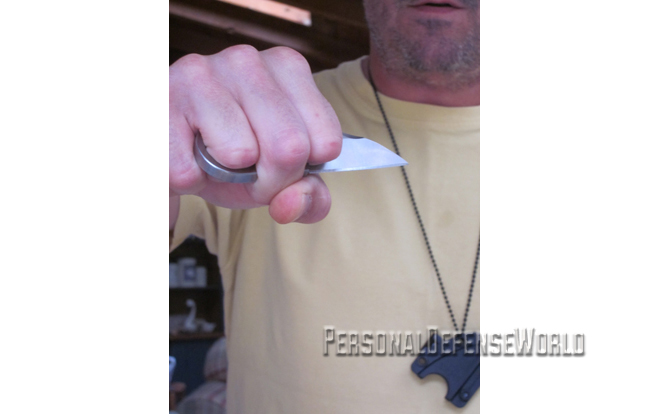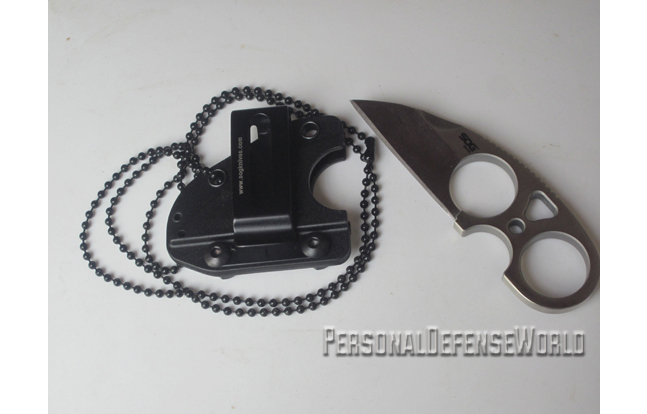Since the first stick was ground to a point and the first rock was flaked for a sharp edge, mankind has been using fighting blade (edged and pointy) weapons for offense and defense. As firearms grew more popular, some people relegated the era’s edged weapons to the category of relic, rejecting the need for them. But those facing the sharp edge of violence realized no one weapon would suffice. This was especially true with single-shot blackpowder weapons—edged weapons never misfired or ran dry.
Today, many defensive trainers are proponents of having something “sharp and pointy” on hand for bad-breath-distance confrontations. In a non-permissive area, a firearm (handgun) may be out of the question, but with a few notable exceptions, many areas of the country allow for carrying some type of knife. Also, uniformed officers and those carrying concealed use edged weapons for handgun retention. People who have never been overwhelmed by a determined adversary often hold the erroneous belief that handguns are the solution to all problems. A handily located knife, easily deployed and used, on the other hand, can be your ticket out of a confrontation.
Sharp Idea
One of my favorite trainers is Steve Moses of Bluff Dale Academy, a talented instructor in multiple disciplines. I have watched Moses’ skills grow over the last two decades. Despite his impressive ability with firearms, he has always emphasized that close-range interpersonal confrontations would be, well, close range—nose to nose—and require appropriate skills and equipment. Moses has studied with a number of trainers, including numerous edged-weapons instructors such as Andy Stanford of OPS, Greg Hamilton of Insights, and Craig Douglas, aka “Southnarc.” Moses also worked with Dallas/Fort Worth–area knife builder and trainer Charlie Porter in Pekiti-Tirsia Kali (a combat style specific to Filipino martial arts), further enhancing his understanding of edged-weapons use.
Advertisement — Continue Reading Below
Knives are more likely to be used up close in a hasty disparity-of-force situation rather than in the dueling-style, knife-against-knife combat so often portrayed in cinema. Knife systems came and went as Moses searched for what worked best for him. Craig Douglas’ reverse-edge, fixed-blade Clinch-Pick was the closest to Moses’ conceptual ideal. A fixed blade, it lends itself to reverse-grip, edge-in use (pikal, “to rip” in the Filipino language) but is still quite useable in a forward grip. However, Moses felt a couple of things needed modification to better suit his style. Fixed blades have several advantages compared with folders, including increased strength and faster depolyment speed. Their blades will never precipitously snap closed on a hand, and as for centerline carry, fixed blades are accessible by either hand.
Moses was concerned folks like himself with larger hands, might be in danger of cutting their thumb seriously if they grabbed the Clinch-Pick in a saber grip (thumb atop the traditional knife’s spine), instead of using the hammer grip (thumb down, making a fist) for which it was intended. Also, Moses wanted to modify the blade tip to reduce its potential to be damaged if dropped on hard surfaces. The challenge was to make the modifications without affecting the handling. Moses discussed his thoughts on defensive knives during his edged-weapons classes. When the Clinch-Pick became his carry system, he shared his ideas for improvements. Dedicated student and friend Patrick Jones decided to help Moses create his “perfect” knife. Patrick approached friend and talented bladesmith Steve Woods of Rock River Iron, who also knew Moses.
Going OneUp
After explaining his ideas, Moses left the aesthetics of the new knife, the OneUp, to Woods. Before beginning the project, Woods built a prototype with a traditional, edge-down blade orientation just to get his mind wrapped around the reverse edge. (This version will be available as well.) What went into the OneUp’s production? Crucible’s CPM 154 steel, which is what Woods uses on all his fighting knives. It heat-treats well and sharpens nicely. Woods finds CPM 154 heat-treated to HRC 58-59 produces harder blades (the OneUp’s blade edge is thin) and has better edge retention, toughness and chipping resistance than many steels.
Advertisement — Continue Reading Below
The OneUp’s 4.12-inch blade (with ricasso) has a hollow grind along the 2.75-inch cutting edge. The overall length is 7.25 inches, and the generous choil is 1.27 inches long, cut into a 0.12-inch-thick spine with a false edge applied. Lengthening the ricasso by 1.4 inches reduces the potential for cut thumbs. In comparison, the Clinch-Pick has a Wharncliffe blade, where the point of the knife tapers downward from the spine to a straight cutting edge. To address Moses’ tip-break concerns, Woods added a tanto tip while retaining the Wharncliffe profile, resulting in a blade that retains excellent stabbing and slicing properties. The comfortable, effective, bulbous handle looks striking with G10 scales, which are available in solid gray, OD green and black or in several striped patterns. The handle is polished smooth and secured with brass pins, and the lanyard loop is lined. A Woods-made Boltaron sheath carries the OneUp and attaches to belts with Blade-Tech’s Tek-Lok. This system allows the sheath’s angle to be adjusted as needed for comfort and access. At 3.5 ounces, the OneUp’s weight is easily forgotten, even with the addition of the sheath.
Down To Training
Up front, one thing needs saying: Do not train with a live blade! To that end, a slightly longer, aluminum trainer with the same bulbous handle is being offered. Also, check state and local ordinances regarding carrying a fixed blade. The OneUp is strictly a fighting knife, designed to poke/jab, rip (these are natural moves) and trap very effectively, in the style taught by Moses. During an in-your-face confrontation, the OneUp comes out of the sheath with either hand and immediately goes to work. In the first hour of a Moses’ edged-weapons class, several things come to light. He discusses a number of grip styles, but it is obvious that, with the OneUp, a hammer grip with the edge up and a reverse grip with the edge in are preferred. The hammer (forward, or “monkey”) grip is instinctual, the same as naturally gripping a tool or weapon. The hammer grip with the edge up, as the OneUp orients its blade, allows for in-close, rapid, repetitive stabbing and upward ripping, and at a distance, it works perfectly for snap cuts to the head.
The reverse grip with the edge in (pikal style) shares common traits with the hammer. However, the knife extends out of the bottom of the hand rather than the top. Moses explains, “Reverse grip, edge in—pikal—is used to rip and trap. Greater leverage and power can be incorporated in a pulling motion versus a pushing motion. I believe it is easier to retain the knife and avoid being disarmed with the pikal grip, and it is easier to use when engaged in a life-threatening grapple.” Because he recognizes not everyone is carrying an edge-up knife, his classes are not limited to the pikal style. In class he explains how the human body moves, its weak points and the angles at which a knife can be projected by an attacker. Knife movement (lines of attack) is included as well. With an edged weapon, most of the time there are no “one shot” stops. Accomplishing an immediate stop relies upon blade attacks to the opponent’s eyes or forehead, trachea, underarm and more. Strip attackers of their ability to move, and the fight will be over.
Advertisement — Continue Reading Below
Conventional knives can be applied in slashing/slicing, stabbing, ripping and other motions, as well as with specialty moves like the snap cut. The stance is primarily strong-side foot slightly forward, slightly off square, to permit a quicker, longer launch, which is perfect for snap cuts. This stance permits lateral movement easily and allows defenders to move laterally without a major initial balance shift. The hands are up and moving, but the non-dominant hand is not extended beyond the knife hand’s protection.
Because the OneUp is designed primarily for “intimate” encounters, you may or may not be able to use the same stance. The non-dominant hand will be busy protecting vital areas and attacking/striking those same areas on the attacker. With the OneUp, the pikal moves are, aptly, quick and repeated stabs, rips accompanying the stabs, hooks to limbs, and arcing slashing attacks. Held in the forward grip with the edge up, the OneUp can be used for snap cuts. However, the OneUp’s use does not stop there. Use of the OneUp includes grappling and striking, before and after drawing.
The Takeaway
Folks who believe they can deploy folding knives as effectively as fixed blade knives during a grapple are fooling themselves. Of course, where and how the fixed blade is located on your person is an important factor in the fixed blade’s swiftness, and there are many advantages to carrying on the body’s centerline. Steve Moses and Steve Woods have created an updated version of the Clinch-Pick that Craig Douglas made so famous. The more damage-resistant tip and longer ricasso are positive enhancements. Its light weight and adaptability make the OneUp a great choice for everyday carry, and the blade orientation should prove very effective in the hands of a trained user.
Advertisement — Continue Reading Below
I trust the OneUp to get me out of a bad situation—as long as I do my part. For more on the OneUp, visit rockriveriron.com. For more on Moses, call 817-308-2607, or visit bluffdalefirearmsacademy.com.
BUY NOW! AT www.personaldefenseworld.com/magazines/personal-home-defense/.
